What is Wavetable Synthesis?
Wavetable synthesis dates back almost 50 years. There is some confusion as to whether in the PC world it is true "wavetable synthesis", so to avoid confusion I will use the term wavetable here to mean "sample-based synthesis", which is what it truly is.
The term "wavetable" became mainstream for most PC users when Creative Labs introduced the Sound Blaster 16 in June 1992, which was the first sound card to come with what they called the Wave BlasterTM header - a connector onto which you could install a daughterboard called the Wave Blaster (CT1900). This added hundreds of real instrument and drum kit samples that could be used to bring more authentic music and sound effects to your PC. It used a wavetable patchset called E-MU Sound Engine Rev. A from a specialist audio company called E-Mu.
But what came before it? Queue the music....

The storing of instrument samples was nothing new in 1992. From a PC audio perspective the idea of using sample-based synthesis came about 5 years earlier with the introduction of the Roland MT-32 Music Synthesizer Box, and its MPU-401 interface that became ubiquitous.
Leap forward to 1991 when Advanced Gravis launched the first audio card, the UltraSound, that used software-based samples that could be loaded into onboard RAM instead of having them stored on a ROM chip. This meant you could change the samples to suit what you were doing [or the game you were playing!]. Because of the flexibility of using different patchsets (a collection of samples held in a single file), their UltraSound sound card could be considered one of the first cards that met the General MIDI standard, which was also announced the same year.
In the world of PCs once wavetable synthesis was well established, it came in 3 flavours:
- An external sound module, such as the Roland MT-32, Roland SC-55, or Yamaha MU80
- A sound card with no wavetable support by itself, but had a wavetable header into which you could plug in a wavetable daughterboard. An example of this was the Sound Blaster 16 sound card with a Wave Blaster daughterboard.
- A sound card with built-in wavetable, e.g. Advanced Gravis UltraSound, Sound Blaster AWE32, or MediaTriX AudioTriX Pro
All of the above achieve the same thing, though the audio quality can differ massively depending on what you get. For the majority of PC gamers, if you had any of the above you had effectively drastically upgraded the music portion of your PC gaming audio! While wavetable synthesis did include some sound effects such as birds chirping or a bell ringing, the majority of games tended to continue to use the PCM 'digital audio' part of a sound card rather than a sample for sound effects.
So where previously when preparing to play your favourite game you simply chose 'Ad Lib' or 'Sound Blaster' in the setup utility, you now had two settings to change: one for music and a second for sound effects (digital audio). For Sound Effects this was usually the same as before - something like 'Sound Blaster'. But for music you would instead pick "MT-32" or "General MIDI".
Let's dig a little deeper into the 3 wavetable flavours mentioned earlier...
1. External Sound Modules
External sound modules have been covered in other topics here on DOS Days - there is a lot of information on my General MIDI page, so I won't cover much more of that here, apart from to say that the cost to own one of these back in 1987 when Roland first introduced the MT-32 external music synthesizer was far too high for most folks - $697! These days you can pick up a used external MIDI module for around £100 plus shipping.
As the name implies, these are external boxes which receive MIDI messages from your computer, process those messages, and output the actual audio either directly to speakers connected to the MIDI module or back to your PC sound card's "Line-In" socket to be mixed into the overall audio output.
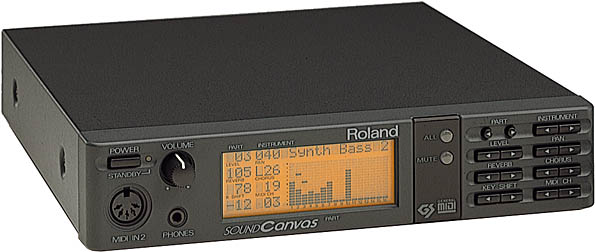
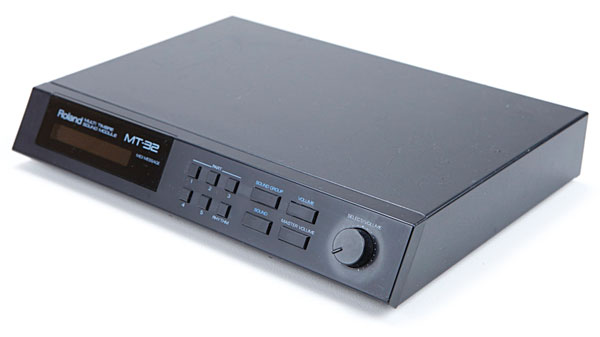
External MIDI Modules
2. Sound Cards with a Wavetable Header
The earliest sound card that supported wavetable synthesis was the Sound Blaster 16 which came with a new 26-pin header called the Wave Blaster connector. By purchasing the Creative Labs Wave Blaster (CT1910) daughterboard and plugging it into this connector, your SB16 could now output sample-based audio that was compatible with the General MIDI standard. Without the daughterboard attached it could only output the poorer-quality FM synthesis.

The 26-pin Wave Blaster header on a sound card
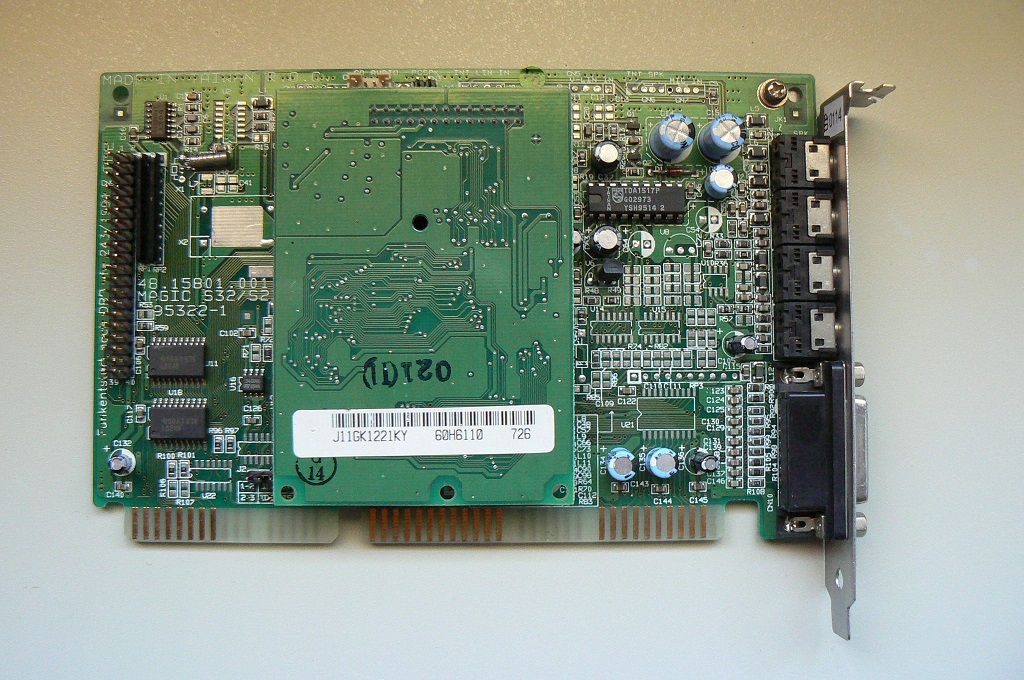
A wavetable daughterboard installed onto the sound card
Wavetable daughterboards such as the Wave Blaster came with a ROM chip onto which were stored hundreds of sounds of real instruments (called "samples" or "patches"). A collection of sound samples put together are often referred to as a "patch set", a "soundbank", or a "soundfont".
While the original Wave Blaster greatly improved upon the acoustic quality of the Sound Blaster 16's built-in FM-synthesis, the acoustic quality of its instrument-set (patch set) was regarded poorly by the general public. Despite this, the Wave Blaster sold well (Creative Labs were very good at marketing!), and soon Creative launched the Wave Blaster II which came with a new synthesis engine, EMU8000, again from specialist audio company E-Mu. This would later also be used on their AWE32 sound card.
Furthermore, other manufacturers recognized that this technology was where the PC audio market was heading, and they too added a Wave Blaster-compatible header to their new sound cards - it was a very cheap cost to add the header since all the actual costly technology would be on the daughterboard you had to buy separately. These manufacturers also created their own Wave Blaster-equivalent daughterboards so owners could extend their sound card's audio support to include General MIDI. Even budget sound cards eventually came with a Wavetable header to the point it's actually quite rare to find a sound card that did not support this expansion option from 1993 onward.
3. Sound Cards with an Internal Wavetable
The first sound card that came with built-in wavetable synthesis, i.e. no need for a daughterboard, was the Advanced Gravis Ultrasound, launched in 1991. Its audio quality was considered excellent, but the card suffered by not having hardware support for Ad Lib or Sound Blaster which the vast majority of games supported, and within a year or two faded into obscurity.
During the early to mid 1990s, other manufacturers including Ensoniq, Terratec, Roland, MediaTriX, Orchid, Turtle Beach, Miro and Yamaha released higher-end cards that had a built-in synth chip and a wavetable patchset in ROM, coupled with an FM synthesizer for backward compatibility with older games plus digital audio for sound effects. These all-in-one sound cards gave the owner the option to choose from a broad array of game audio setup choices.
Most of these high-end cards also got a Wave Blaster-compatible header if you wanted to replace the onboard patchset with a different one, though daughterboards didn't come cheap.
One thing to bear in mind is that some of these cards' wavetables were not General MIDI-compatible, so could sound odd if you chose the GM (General MIDI) option in games. The hardware manufacturers' expectation I guess was that game designers would write specifically for their card's wavetable. Some cards also required you to load in a TSR or driver for it to work with the "General MIDI" option in games. As I understand it, this is because these cards lacked a true MPU-401 interface which had become the de facto standard for communication to a GM device. The TSR was required in order to capture incoming MIDI messages and redirect them to the wavetable synth chip. Such cards that need a TSR running to work include the Turtle Beach MultiSound Classic, Prometheus ARIA 16, and Creative Labs Sound Blaster 32, AWE32 and AWE64.
Patchsets
Most of the major sound card and daughterboard manufacturers did not create their own patchsets; instead they bought the rights to use someone else's. Originally these cards came only with a ROM chip that had the patchset stored on it. Later cards replaced these with RAM slots instead, whereby the patchset had to be loaded into RAM each time the wavetable was to be used (like the Advanced Gravis UltraSound did!). These were usually referred to as a "SoundFont". Some cards came with both - a patchset held in ROM as well as some onboard RAM to load your own patchset into (which would usually disable the onboard ROM's patchset), thereby giving you the best of both worlds.



Was a particular patchset General MIDI (GM) or not?
Most synths were officially GM-compatible. All this really meant was that as a minimum they would have the predefined set of 128 GM instruments in their instrument table (General MIDI states that Instrument #1 is a Piano, instrument #7 is a Harpsichord, and so on). Special effects were deliberately not made a part of the GM standard, leaving that up to each manufacturer to choose how to manipulate a musical instrument's actual sound. This results in a fantastic variation of sounds even for a single instrument, with reverb, chorus, etc.
For games developers to be able to write music that worked across the majority of wavetable hardware, adherance to a standard was of the utmost importance, and the wavetable hardware manufacturers knew this. So making sure their wavetable boards would work to the General MIDI standard or one of its supersets, GS (Roland) and XM (Yamaha), would mean their board could claim to work with the broadest range of games titles.
The list below contains some of the more common synthesizer chips and their patchsets you will find on wavetable daughterboards and sound cards that have an internal wavetable. Because each patchset was recorded using different actual instruments, or has been processed after recording, they will have subtle [and sometimes not so subtle] audible differences. In addition to that, many synthesizer chips also have an embedded effects processor that can be programmed to further adapt the acoustics of a sample.
Note that the size of the sample ROM does not always indicate the quality of the samples, though it is usually safe to assume that a wavetable card or daughterboard with a smaller ROM capacity either means it has fewer samples or its samples have been heavily compressed, thus reducing their quality.
It's very subjective, I know, but in terms of sample quality I would rate these wavetable ICs [and their accompanying samples] something like this [in alphabetical order]:
 AdMOS QDSP QS700
AdMOS QDSP QS700
Released: 1995
ROM Size: 512 KB, 1 MB
Patchset: (own)
Polyphony: 32 voices
The QS700 (and rebranded OPTi 82C941) could handle 32 voices at 44.1 kHz, which is CD quality. It supported a maximum of 16x8M sampling memory.
Found on the following sound cards:
- Silicom Multimedia Systems' WaveMaster 32FGP rev 1.2 (512 KB patchset ROM)
- Silicom Multimedia Systems' FGP
- AST Advantage DB II-A Wavetable card
- Labway card (FCC ID: LWHA111800)
- Super Sound Origins 32W-3D
.jpg)
.jpg) AdMOS QDSP QS1000
AdMOS QDSP QS1000
Released: 1996
ROM: AdMOS QDSP QS1001A
ROM Size: 512 KB, 1 MB or 2 MB
Patchset: (own)
Polyphony:
32 voices
Found on the following cards:
- Diamond Monster Sound wavetable daughterboard (AdWave 32S) - 512 KB or 2 MB version
- Diamond Wavemaster DB-II - 512 KB
- Silicom Multimedia Systems' WaveMaster 32 (FCC ID: M4TWM6H6)
- Silicom Multimedia Systems' WaveMaster 32FGP Rev 2.x (OPTi 82C931)
- Silicom Multimedia Systems' WaveMaster 64FGP (512 KB patchset ROM)
- Trust Sound Expert de Luxe Wave 32 3D
- Highscreen Sound Boostar 16/32 3D PnP (FCC ID: LWHA211A60)
- Serdaco QWave
- Yamaha Audician 32 Plus cards, e.g. Addonics A151-A00 and Philips PCA750AF - on both these the cards have solder pads only - no wavetable or ROM chips present.
- A-Trend ATC-6631 (optional, though I've never seen this card with a QS1000 fitted)
- Behavior Tech Corp BTC-1817DWS (FCC ID: E5X1817)
- Avance Logic Pro32AW wavetable daughterboard
In 2022, Serdaco launched the QWave, a Waveblaster-compatible sound PCB based on the QS1000 chipset + QS1001A 4Mbit ROM. In February 2022 it sold for 55 EUR, featuring:
- 32 voices polyphonic playback at 44.1 KHz
- Advanced Time Variable filter and amplitude control (ATFA)
- Advanced Q PCM sound synthesis
AMD Interwave AM78C200LC
Released: 1996
ROM Size:
512 KB
Patchset: (own)
Polyphony: 32 voices
The Interwave "LC" (Low Cost) was a cost-reduced version of the earlier AM78C201. Found on the following:
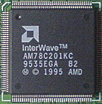
AMD Interwave AM78C201KC / AKC
Released: 1995
ROM Size:
1 MB or 2 MB, but also supported up to 16 MB RAM for software-installed patchsets
Patchset: (own)
Polyphony: 32 voices
The Interwave was named AMaDeus at its launch in 1995, and was a licensed version of Advanced Gravis' GFA1 synth chip found on their UltraSound audio card. When AMD licensed it, they enhanced the chip to support up to 16 MB of onboard RAM (via two 30-pin SIMM memory slots). It was compatible with the Crystal CS4231 codec installed in the UltraSound MAX and the 16-bit recording daughterboard for the UltraSound Classic.
The sound "patch set" was reworked from a collection of individual instrument .PAT files to a unified .FFF/.DAT sound bank format, resembling SoundFont, which could be either ROM or RAM based. There were 4 versions of the sound bank: a full 16-bit ADPCM 4 MB with 8-bit downsampled 2 MB version, and 16-bit ADPCM 2 MB (different sample looping) with 8-bit downsampled 1 MB version.
Interwave was licensed to a number of OEMs including ExpertColor, STB Systems, Reveal, Compaq, Philips and Core Dynamics. Some high-end OEM variants contained a full-blown 4 MB patch set in ROM and proprietary hardware DSPs to enable features like additional sound effect algorithms and a graphic equalizer.
Click here for the Am78C201/202 datasheet.
The AM78C201AKC was a later revision of the standard AMD InterWave chip which also got an integrated TEA6330T fader. It was used on a Compaq OEM version of STB Systems' Ultra-Sound 32.
The AMD InterWave synth chip can be found on:
- Advanced Gravis UltraSound PnP
- Advanced Gravis UltraSound 32 Pro
- STB Systems EC251
- ExpertColor MED3201
- Philips PCA761AW
- Reveal WAVExtreme 32 (FCC ID: LCE-XTREME32A)
- Core Dynamics DYNASonix 3D/Pro (FCC ID: MUBSONIX3D) (1996) Box
- Orpheus II
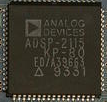
Analog Devices ADSP2115
Released: 1993
ROM Size:
512 KB, 1 MB
Patchset: unknown
GM-compatible: Yes
Polyphony: 24 voices
Found on Orchid SoundWave 32 (512 KB or 1 MB ROM versions exist, both of which have compressed samples). No TSR is needed for the card to access the wavetable.
Click here for the ADSP2115 datasheet.
Aztech AZT3310 / AZT3320
Released: 1996
ROM Size:
1 MB ROM
Patchset: Samsung, software-based
Polyphony: unknown
The AZT3310 is a rebranded Samsung KS0164. Found on some variants of the Aztech WaveRider Pro 32-3D. It does not require a TSR to be loaded to make use of the wavetable synthesis.
Creative Labs EMU8000/EMU8K
Released: 1994
ROM Size:
1 MB ROM
Patchset: own EMU8011
GM-compatible: Yes
Polyphony: 32 voices
The EMU8000 chip incorporates an effects processor which can generate chorus and reverb effects, and environments on its MIDI output, similar to the later EAX standard that Creative Labs released on its "Live!" brand of cards. Unlike nearly all other synth chips listed here, the Sound Blaster AWE32 did *not* use the card's MPU-401 interface to access the EMU8000 - instead its registers in the synth chip are exposed via three sets of non-standard ports, and interpret MIDI commands in software on the host CPU. This means software such as games have to directly support the AWE32 to work, rather than simply permitting the "General MIDI" option to work. The AWEUTIL program is what attempts to redirect General MIDI/MT-32/GS commands to the native AWE32 hardware.
It requires a TSR to be loaded to make use of the wavetable.
Click here for the EMU8000 Programmer's Guide.
Found on the following:
- Creative Labs Sound Blaster AWE32
- Creative Labs Sound Blaster AWE64
- Creative Labs WaveBlaster II (CT1910) wavetable daughterboard
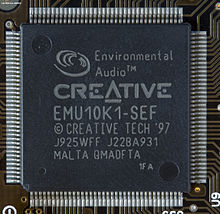
Creative Labs EMU10K1
Released: 1998
RAM Size:
8 MB RAM
Patchset: Ensoniq, software-based
Polyphony: 64 voices
Creative Labs released the EMU10K1 alongside its new Sound Blaster Live! range of cards in 1998. The EMU10K1 featured 64-voice polyphony, support for DirectSound as well as EAX 1.0 and 2.0, plus an embedded DSP chip for effects processing.
Unlike its predecessor, the EMU8000, which used a ROM chip to store its patchset, the EMU10K1 used only system RAM to read a software patchset over the much faster PCI bus.
No ISA cards got the EMU10K1 chip due to its design. EMU10K1 can be found on the following PCI sound cards:
- Creative Labs Sound Blaster Live! Value / Live! 1024 (CT4670)
- Creative Labs Sound Blaster Live! / Live! X-Gamer, Live! X-Gamer 5.1, Live! Platinum and Live! MP3+ (CT4760)
- Creative Labs Sound Blaster Live! (Dell OEM version of CT4670) (CT4780)
- Creative Labs Sound Blaster Live! Value / Live! 1024 (CT4830)
- Creative Labs Sound Blaster Live! 5.1 / Live! 5.1 Platinum, Live! 5.1 X-Gamer / Live! 5.1 MP3+ (SB0060)
- Creative Labs Sound Blaster Audigy Platinum (SB0090)
- Creative Labs Sound Blaster Live! 5.1 (SB0100)
- Creative Labs Sound Blaster Live! 5.1 Digital (SB0220)
- Creative Labs Sound Blaster Live! 24-bit (SB0410)
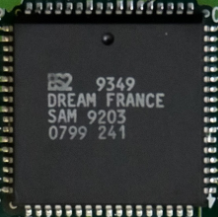 Crystal CS9203 / DREAM SAM9203
Crystal CS9203 / DREAM SAM9203
Released: 1993
ROM Size:
1 MB ROM (Crystal), 4 MB ROM (Dream)
Patchset: Dream CS4112-CS (possibly of Roland origin)
Polyphony: 32 voices
The Dream SAM9203 has a 4 MB ROM instead of the 1 MB Crystal-branded variant (Crystal Semiconductor were an authorised chip fabricator for Dream, and were permitted to have their chips branded 'Crystal').
Found on the following:
- Terratec WaveSystem SCW001 (2 MB ROM)
- Gallant GMW-1000 wavetable card
- Hizon DB333, a.k.a. Formosa 16-bit AudioStar Wave
- MultiWave DreamWave wavetable daughterboard (Part #MW-0203125) - sold separately but also came bundled in what they called AudioWave AWS32 (a Platinum 16 sound card + this DreamWave DB). The DB is pretty large so may not fit on other sound cards where their low height prevents its use.
- Toptek Golden Sound 32 (GS-32 PCM Interface) - a 16-bit ISA card with General MIDI-only capability. Be careful of resource conflicts as this card has a game port and can be configured to use IRQs 2-7.
Apparently, the software drivers for these daughterboards come with two MIDI files that are used to enable or disable the MT-32 emulation in DOS. They are called "set_mt32.mid" and "set_gmgs.mid".
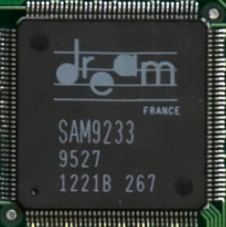
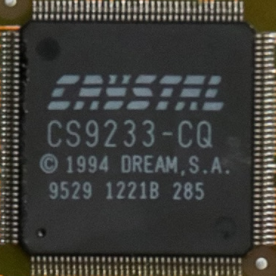 Crystal CS9233 / DREAM SAM9233
Crystal CS9233 / DREAM SAM9233
Released: 1994
ROM Size:
1 MB or 4 MB ROM
Patchset: Dream CS4112 (possibly of Roland origin)
GM-Compatible: Yes
Polyphony: 32 voices
The patchset is either Dream's CleanWave 32, or the one they got into trouble over with Roland. It does require a TSR to be loaded to make use of the wavetable synthesis.
Found on many cards including:
- Aztech CS9233 wavetable card
- Terratec Maestro 16/96 and 32/96
- Terratec WaveSystem Professional SOWT-24
- Terratec MiniWave System SOWT-12 and SOWT-11
- Orchid NuSound PnP 32
- Oksori WS32
- Ad Lib ASB 64 Wave Pro 4D IDE
- AOpen AW32 Pro
- Formosa AudioStar Wave (daughterboard)
- IBM Aptiva S-W1/C Wavetable card
- Zoltrix Audio Plus 3200 AV500
- Zoltrix Audio Plus 3200 V2 AV305
- Dream PW-32 Pro
- Powerwave
- Shark Multimedia Tsunami
- QVision MidiStar/GS
Click here for the CS9233 Datasheet.
Crystal CS9236
 Released: 1997
Released: 1997
ROM SIze: unknown
Patchset: unknown
GM-Compatible: Yes
Polyphony:
32 voices
Found on the following cards:
- AOpen AW35 Pro (FCC ID: IPLAW35)

Dream SAM2195
Released: 2014
ROM SIze: 512 KB ROM
Patchset: unknown
GM-compatible: Yes
Polyphony: 64 voices
Found on the Serdaco Dreamblaster S1 wavetable daughterboard.
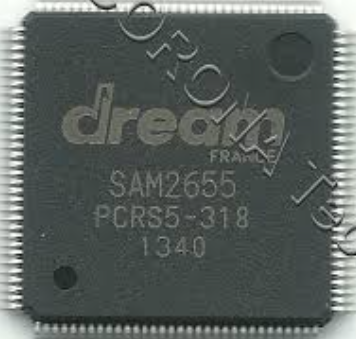
Dream SAM2655
Released: 2015
ROM SIze: 8 MB ROM
Patchset: unknown
GM-compatible: Yes
Polyphony: 64 voices
Click here for the SAM2655 datasheet.
Found on the Serdaco Dreamblaster X1 wavetable daughterboard.
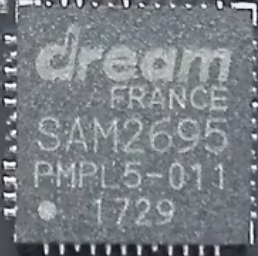
Dream SAM2695
Released: 2014
ROM SIze: 8 MB ROM
Patchset: unknown
GM-compatible: Yes
Polyphony: 64 voices
Found on the follows wavetable daughterboards:
- Serdaco Dreamblaster S2
- Lotharek Sam-Wave
.jpg)
.jpg)
Lotharek SAM Wave wavetable daughterboard images, courtesy of targeted.
Dream SAM9407
/SAM9407.png) Released: 1996
Released: 1996
RAM Size: 4 MB RAM, software-installed patches
Patchset: unknown
GM-Compatible: Yes
Polyphony: unknown
The Dream SAM9407 uses soundfonts in the .94B file format.
Note that the Hoontech Soundtrack 97 uses files with a .DMF extension but the format is still .94B - just rename the file extension.
Terratec files sometimes use a .TTS file extension - these files simply add a header to a .94B file, so could be manipulated to work with the SAM9407.
Found on the following cards:
- Terratec EWS64XL
- Guillemot MaxiSound 64
- Guillemot MaxiSound Game Theater 64
- Hoontech Soundtrack 97
Click here for the SAM9407 Datasheet.
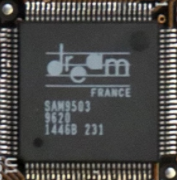
Dream SAM9503
Released: 1997
ROM Size: 1 MB ROM
Patchset: own
Polyphony: 32 voices
Found on Terratec MiniWaveSystem WT64.
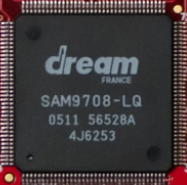
Dream SAM9708
Released: 2005
ROM Size: 16 MB ROM
Patchset: CleanWave (GMS970800, GMBK9708.94B)
Polyphony: 128 voices
Found on Terratec Producer Wave XTable (TT9708WT).
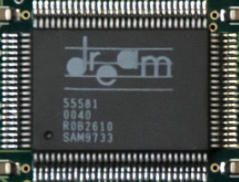
Dream SAM9733
Released: March 1998
ROM Size: 4 MB ROM
Patchset: "CleanWave 32" (GMS973200, GMBK9732.94B)
Polyphony: 48 voices
Dream released 4 new sound synthesis/processing ICs in March 1998. They were the SAM9707, SAM9703, SAM9713 and SAM9733. The SAM9707 was a marketed as a direct replacement for the SAM9407 on high-end PC sound cards and the SAM9703 was to replace the SAM9503 on high-end karoake systems. The SAM9713 was marketed for use in karaoke systems, and the SAM9733 for low-cost keyboards.
The CleanWave 32(TM) is possibly a Roland patchset used without permission. Roland took Dream to court over the use of their samples/patches and won. On 2nd October 1997, Dream and Crystal Semiconductor acknowledged Roland's copyright in its digital sound recordings. Roland then authorised Dream (and its parent company, Atmel) to resell ICs with Roland GS recordings on. CleanWave 32 came with 128 GM instruments plus 195 variations, 9 drumsets and 1 sound effects set.
Dream also produced a CleanWave 8 (1 MB ROM), CleanWave 16 (2 MB ROM), and CleanWave 64 (8 MB ROM).
Used on the following:
- Diamond Monster MIDI
- Miditemp DS-48 CleanWave32 daughterboard
- Serdaco Yucatan FX (a remake of the Turtle Beach Cancun FX)
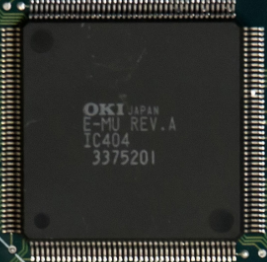
E-Mu Sound Engine IC404
Released: 1993
ROM Size: 4 MB ROM
Patchset: own
GM-Compatible: Yes
Polyphony:
32 voices
E-Mu used OKI Semiconductor for chip fabrication of the IC404.
Found on the original Creative Labs Wave Blaster (CT1900).
E-Mu Proteus 1/XR
Released: 1994
ROM Size: 4 MB ROM
Patchset: own
Polyphony:
32 voices
Found on the original Turtle Beach MultiSound.
Proteus SoundEngine MIDI Specifications
Ensoniq ES-5530 "Opus"
 Released: 1995
Released: 1995
ROM Size: 1 MB ROM
Patchset: own
Polyphony:
32 voices
Found on Ensoniq SoundScape Opus, which is a cut-down version of the S-2000 and Elite. You do not need to load a TSR to make use of the onboard wavetable synthesis. Also found on the NEC Harmony.
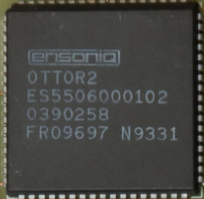
Ensoniq OTTO R2
Released: 1992
ROM Size: 2 MB ROM (Soundscape, Elite, MediaFX, Aztech), 1 MB ROM (VIVO90)
Patchset: own
GM-Compatible: Yes
Polyphony:
32 voices
I wrote up a full review of the Ensoniq Soundscape VIVO90 in June 2022
Found on the following cards:
- Ensoniq Soundscape S-2000
- Ensoniq Soundscape Elite
- Ensoniq Soundscape VIVO90
- Spea V7 Media FX
- Aztech Sound Galaxy Wave Power (daughterboard)
 ESS ES689
ESS ES689
Released: April 1995
ROM Size: 512 KB (external)
Patchset: own ESS patchset
GM-Compatible: Yes
Polyphony:
32 voices
The ES689 synth chip is typically coupled with a 512 KB wavetable ROM chip such as the ES981 that holds the samples, and a DAC chip. If used in conjunction with one of ESS' ES1xxx AudioDrive chips, no external DAC is required.
Fremont, CA (April 25, 1995) -- ESS Technology, Inc. introduced today the ES689 Wavetable Music Synthesizer chip, an integrated audio processor that delivers superior acoustic performance comparable to expensive professional synthesizers, but at an affordable price. The ES689 can play back 32 voices simultaneously at 44.1 kHz CD-quality stereo audio, producing high fidelity music with the realism of a live symphonic orchestra. The ES689 connects to an ESS Technology, Inc. ES98X ROM, which stores a wavetable instrument sample set from InVision Interactive (Palo Alto, CA). The resulting chipset is General MIDI compatible and supports 128 melodic instruments with 47 rhythm instruments.
Fred Chan, President of ESS Technology, Inc., stated, "ESS Technology, Inc. continues our product leadership in 16-bit stereo PC audio with the ES689 Wavetable Synthesizer. ESS Technology, Inc.'s wavetable synthesizer design, with InVision's wavetable sample set, provides affordable but high-quality wavetable music synthesis."
Scott France, President of InVision Interactive, stated, "InVision Interactive is well-known in the musical instrument industry for providing the highest quality CD-ROM samples for professional music sampling platforms. InVision designed a new library of sounds specifically for the ES689. We believe the InVision sound set for the ES689 provides audio solutions and a price/performance margin for multimedia applications unparalleled in the industry."
The ES689 leverages ESS Technology, Inc.'s AudioDrive product line of 16-bit 44.1 kHz stereo audio processors, highly integrated mixed-signal devices which record and play back 16-bit 44.1 kHz stereo audio. The ES689 contains a simple serial interface control path to connect to ESS Technology, Inc.'s 16-bit AudioDrive components, including ES1688, ES1788, ES1888, ES788, and ES888. This 3-chip complete stereo audio subsystem - with ESS Technology, Inc. 16-bit AudioDrive, ES689 Wavetable Synthesizer, and ES98X Wavetable ROM - includes all on-chip integration for compatibility with software operating in Sound Blaster™ and Sound Blaster Pro™ modes, ESS Technology, Inc.-developed ESFM™ FM music synthesis, and high-quality wavetable synthesis. The ES689 can also interface to any external audio D/A converter to produce the wavetable audio output.
"Wavetable synthesis achieves greater audio fidelity and instrument realism by storing samples of live musical instruments into the ES98X ROM memory," stated Bill Windsor, Strategic Marketing Manager of ESS Technology, Inc. "To play back a note from an instrument selected by the MIDI command stream, the ES689 wavetable synthesizer selects stored samples from the selected instrument and performs complex arithmetic calculations before playing the note, including interpolation between sampled notes, pitch shifting, and filtering. The note played includes overtones and timbre of the real instrument, resulting in very high audio quality.
"The ES689 wavetable expands ESS Technology, Inc.'s existing high-quality audio technology," Windsor continued. "ESS Technology, Inc. developed ESFM music synthesis for our AudioDrive products as a superset to OPL-3™ music synthesis, to produce greater depth of instrument sounds. Wavetable takes that a leap further with outstanding instrument realism."
The ES689 also includes an MPU-401 serial port to interface to General MIDI devices. General MIDI (Musical Instrument Digital Interface) is the control standard defined by the music industry enabling a common control interface between MIDI playback and composition controllers. General MIDI defines a standard for 128 common musical instruments which are invoked by a MIDI playback device; MIDI music synthesis is performed by the music synthesis device such as an FM synthesizer or higher-quality wavetable synthesizer.
The ES689 and ES98X are sampling now. The ES689 is packaged in a 100-pin package. Evaluation Kits will be available in May, including an ES1688/ES689/ES98X Evaluation Board and sound applications software library. Pricing is available by contacting ESS Technology, Inc. directly. " ESS website, April 1995
Click here for the ES689 datasheet.
ESS ES690F
 Released: November 1995
Released: November 1995
ROM Size: 1 MB ROM
Patchset: own ESS patchset, in separate ES981P chip
GM-Compatible: Yes
Polyphony:
32 voices
The ES690 synth chip is typically coupled with a 1 MB ES981P wavetable ROM chip that holds the samples.
Fremont, CA (November 13, 1995) -- ESS Technology, Inc. (NASDAQ: ESST) introduced today the ES690 Wavetable Music Synthesizer chip, an integrated audio processor that delivers superior acoustic performance for the General MIDI instrument set comparable to expensive professional synthesizers, containing an audio effects processor for chorusing and reverberation. The ES690 is packaged in a small 52-pin PQFP package, with advanced power management control capability, providing the industry's smallest wavetable synthesizer chip and facilitating wavetable synthesis integration into desktop PC motherboards, notebook PCs, and add-in multimedia cards.
The ES690, coupled with a new optimized ES981 1MB Wavetable Sample Set ROM containing a new instrument patch set from InVision Interactive (Palo Alto, CA), achieves superior fullness and depth of instrument sounds. The ES690's small package and advanced power management capability make this wavetable solution ideal for notebook and desktop motherboards where board space is at a premium.
"The ES690 Wavetable Synthesizer expands ESS Technology, Inc.'s existing high-quality audio technology," explained Bill Windsor, Strategic Marketing Manager at ESS Technology, Inc.. "The ES690/ES981 provides dynamic instrument realism and audio excitement that users seek in a multimedia PC. The ES690 wavetable synthesizer supports audio effects processing for the entire General MIDI instrument set of 128 melodic instruments with 47 rhythm instruments," he continued.
Fred Chan, President of ESS Technology, Inc., stated, "The ES690 Wavetable Synthesizer builds on our already strong AudioDrive® and Wavetable audio product family. The addition of chorusing and reverb effects in the ES690, coupled with a new improved 1MB wavetable sample set from InVision, provides a new richness of wavetable sound superior in the industry."
"InVision Interactive is well-known in the musical instrument industry for providing the highest quality CD-ROM samples for professional music sampling platforms," stated Scott France, President of InVision Interactive. "InVision designed a new library of sounds specifically for ESS Technology, Inc.'s ES689 & ES690 Wavetable Synthesizers. We believe the InVision sound set for the ESS Technology, Inc. wavetable provides audio solutions and a price/performance ratio for multimedia applications unparalleled in the industry."
The ES689 and ES690 Wavetable Synthesizers can each play back 32 voices simultaneously at 44.1 kHz CD-quality stereo audio, producing high fidelity music with the realism of a live symphonic orchestra. The ES690 complements ESS Technology, Inc.'s AudioDrive product line of 16-bit 44.1 kHz stereo audio processors, highly integrated mixed-signal devices which record and play back 16-bit 44.1 kHz stereo audio.
The ES690 contains an MPU-401 serial port to interface to General MIDI devices. The ES690 connects with a 2-wire serial control interface to ESS Technology, Inc.'s AudioDrive components, including ES1688, ES1788, ES1868, and ES1888. The ES690/ES1x88 pair supports today's major audio standards including Microsoft® Windows 95™, Windows™ 3.1, Microsoft Game SDK, Windows NT™, and Windows Sound System‡ 2.0; in addition to IBM® OS/2 Warp™ operating systems.
The ES689 Wavetable Synthesizer and ES981/ES982 Wavetable Sample Set ROMs are in production now. The ES690 is sampling now. The ES690 is packaged in 52-pin and 100-pin PQFP package versions. Evaluation Kits will be available in May, including Evaluation Boards for ES1688/ES690/ES98X/ES938, and a sound applications software library. Pricing is available by contacting ESS Technology, Inc. directly. " ESS website, 13th November 1995
Click here for the ES690F datasheet.
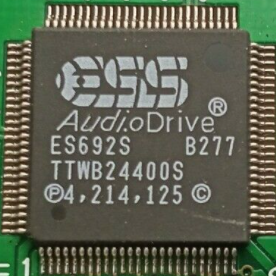
ESS ES692S
Released: 1997
ROM Size: Internal 1 MB ROM
Patchset: own, with 128 melodic and 47 rhythm instruments
Polyphony:
32 voices
The ES692S differs from the ES690F in that it contains its own 1 MB ROM for wavetable samples held internally. It also has a reverb effect with the need for external RAM.
Found on the following:
Click here for the ES692S datasheet.
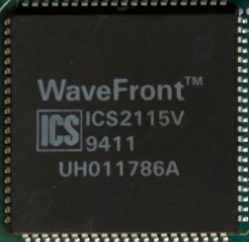
ICS WaveFront ICS2115V
Released: 1993
ROM Size: 2 MB ROM
Patchset: VoiceCrystal Lite (4 MB cut down to 2 MB)
Polyphony:
32 voices
On the Turtle Beach Tropez, the GM sound quality is average - better than E-Mu 8000 and AdMOS. It does require you to run a utility if you wish to use the wavetable synthesis, which is effectively firmware that tells the card's processor to use a certain patch map (from ROM). There is no effects processor.
Click here for the ICS2115V datasheet.
Found on the following cards:
- Turtle Beach Tropez / Tropez+
- Turtle Beach Maui
- Turtle Beach Rio (4 MB ROM - same patchset, just uncompressed)
- Aztech Wavetide daughterboard
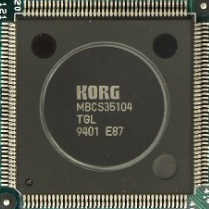 Korg AI-2 (MBCS35104)
Korg AI-2 (MBCS35104)
Released: 1991
ROM Size: 4 MB ROM
Patchset: Cleanwave
Polyphony:
32 voices
Has chorus and reverb special effects.
Found on the following cards:
- MediaVision Pro Wave daughterboard (Part #: 650-0120-04D)
- MediaVision Pro 3D sound card (Part #: 650-0122-01)
- Trust Korg Super Sound Module (SCW 020) / Guillemot Korg Wave Upgrade
Kurzweil MA-1
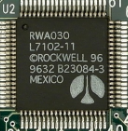 Released: 1997(?)
Released: 1997(?)
ROM Size: 2 MB ROM
Patchset: own, 4 MB of samples compressed to fit in a 2 MB ROM
Polyphony:
32 voices
Considered to be possibly the best quality patchset available, the samples were compressed using a proprietary compression algorithm by Kurzweil to ensure minimal loss of quality. The instruments comes across as more harmonised and cinematic. It is ideal for orchestral music.
On the Turtle Beach Pinnacle sound card you could install up to 48 MB of 30-pin FPM RAM to expand the sample set. It supported individual reverb and chorus settings on each MIDI channel.
On the Turtle Beach Malibu Surround 64, the Kurzweil MA-1 synth and 2 MB ROM chip (with 4 MB compressed samples) are present, though the Rockwell effects processor is missing.
Kurzweil samples are also found on Rockwell-fabricated ICs.
Found on the following cards:
OPTi 82C941
 Released: 1995
Released: 1995
ROM Size: 1 MB ROM
Patchset: own VLSI
GM-Compatible: Yes
Polyphony:
? voices
A rebranded AdMOS QDSP QS700 but with a 1 MB ROM.
Click here for the 82C941 datasheet.
Found on the following cards:
- SIC Resource Super Sound Origins 32W-3D (FCCID: OPT32W3D) - uses the QS702/QS703 patch set.
- Trust Sound Expert de Luxe Wave 32 3D
Philips SAA7785 ThunderBird Avenger
 Released: 1999
Released: 1999
ROM Size: 2 MB ROM
Patchset: own VLSI
GM-Compatible: Yes
Polyphony:
64 voices
The Philips SAA7785 Thunderbird was a PCI sound accelerator chip, which encompassed a wavetable synthesizer, 3D positional audio, DirectSound/EAX/Aureal 3D (A3D) and much more. In 1999 Philips bought VLSI, who had already produced their 4-channel ThunderBird 128 PCI chip. This was used on Philips new range of PCI sound cards including the Philips Rhythmic Edge (PSC702) and Philips Seismic Edge (PSC704).
The Thunderbird Avenger was the follow-up to this chip. Philips updated the Rhythmic Edge and Seismic Edge cards to use this new chip. These cards were very highly regarded for their excellent SnR (Signal-to-Noise Ratio).
Found on the following cards:
- Philips Rhythmic Edge (PSC703)
- Philips Seismic Edge (PSC705)
- Philips Acoustic Edge (PSC706)
Rockwell WaveArtist 030 / RWA030/035
 Released: 1996
Released: 1996
ROM Size: 2 MB ROM
Patchset: Kurzweil, 4 MB of samples compressed to fit in a 2 MB ROM
Polyphony:
32 voices
Found on Turtle Beach HOMAC daughterboard.
Click here for the KS0164 datasheet.
Roland R15239148
 Released: -
Released: -
ROM Size: 4 MB ROM
Patchset: own Sound Canvas SC-55
Polyphony: 24 voices
Roland TC24SC201AF (Toshiba-produced)
Released: -
ROM Size: 4 MB ROM
Patchset: own Sound Canvas SC-55
Polyphony: 24 voices
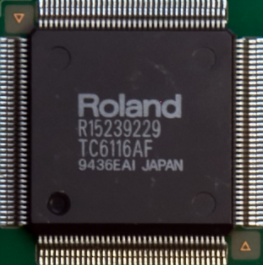 Roland TC6116AF
Roland TC6116AF
Released: 1995
ROM Size: 4 MB ROM
Patchset: own Sound Canvas SC-55 Mk II
Polyphony: 28 voices
Roland used the Toshiba fabrication plant to manufacture the TC6116AF.
Use on the following:
- Roland SCB-7 wavetable daughterboard
- Roland SCD-10 (SCB-7 bundled with the MPU-401/AT)
- Roland SCC-1 sound card
- Roland SCB-55 wavetable daughterboard
- Roland SCD-15
Roland MBCS30109 (Fujitsu-produced)
Released: -
ROM Size: 4 MB ROM
Patchset: own
Polyphony: unknown
Found in the Roland SC-88.
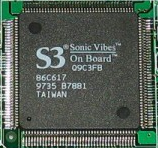
S3 Sonic Vibes
Released: 1997
ROM Size: 2 MB ROM
Patchset: EuPhonics
Polyphony: 32 voices
A PCI wavetable synthesizer chip. Uses the same .DLS soundfont format (Downloadable Sound) as Aureal Vortex.
Found on the following:
- Turtle Beach Daytona (PCI)
- ExpertColor MED6617
- Aztech SC128-3D (PCI)

SEC [Samsung] OmniWave KS0164
Released: 1995
ROM Size: 1 MB, 2MB or 4 MB ROM
Patchset: Sequoia Pegasus, stored in KS0174-1M01 (daughterboard variant) or KS0174-1M04 (sound card variant)
Polyphony: 32 voices
OmniWave, or ΩmniWave to give it its true moniker, supported three sample ROM sizes: 1 MB (KS0174-1M), 2 MB (KS0174-2M) and 4 MB (KS0174-4M). The available sample sets were 512Kx16-bits, 1Mx16-bits, or 2Mx16-bits, and all are GM-compliant as well as Roland MT-32 sound set-compatible.
All samples are processed at 44.1 kHz, and the KS0164 supports 8-bit or 16-bit signed linear samples in addition to 8- and 12-bit compressed samples.
The chip also provides two embedded MIDI interfaces. First is a Roland MPU-401 compatible interface. Not only is UART mode fully supported, but a subset of intelligent mode commands are also supported on this. The second is an on-chip MIDI UART which works independently of the MPU-401 interface, allowing KS0164 to be used in standalone MIDI modules and Wave Blaster-type daughterboard applications.
Click here for the KS0164 datasheet, and here for the overview sheet.
Found on the following:
- Aztech WaveRider Platinum 3D PnP (MMSN853)
- Aztech WaveRider Pro 32 PnP (MMSN852)
- Procomp Pro-Multimedia
- Pine Technology PT-202 Vivaldi daughterboard
- MediaForte SoundForte SF32-WTS-01 daughterboard
- AOpen FX-3D Plus

Sierra Semiconductor SC18005CQ
Released: 1992
ROM Size: 512 KB ROM
Patchset: own
GM-Compatible: Yes
Polyphony: 32 voices
Click here for the SC18005CQ datasheet.
Found on Prometheus ARIA 16 sound card. It requires a TSR to be loaded to make use of the wavetable.
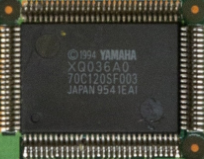
Yamaha XQ036A0
Released: 1995
ROM Size: 4 MB ROM
Patchset: own
GM-compatible: Yes, plus GS and XG
Polyphony: 32 voices
Used on the following:
- Yamaha DB50XG wavetable daughterboard
- NEC XR385 (a DB50XG clone)

Yamaha XU947C0
Released: 1998
ROM Size: 4 MB ROM
Patchset: own
GM-compatible: Yes, plus GS and XG
Polyphony: 32 voices
This Yamaha chip had 16-bit output instead of 18-bit, and lacks the QS300 instrument set found on the XQ036A0. It can be set to run in General MIDI or Yamaha TG-300 / Yamaha XG sound modes.
Used on the following:
- Yamaha DB51XG daughterboard (a cut-down version of the DB50XG)
- Yamaha DX200 external MIDI module
- Korg NX5R external MIDI module
 Yamaha YMF-278B (OPL4)
Yamaha YMF-278B (OPL4)
Released: 1994
ROM Size: 2 MB ROM
Patchset: OPL4
GM-compatible: Yes
Polyphony: 24 voices at 44.1 kHz
Usually accompanied by a Yamaha YMF801 2 MB ROM chip, which holds 330 samples, mostly 22 kHz 12-bit samples with some drums at 44.1 kHz. It is also sometimes connected to a Yamaha YSS225 effects processor chip. Two later versions of the OPL4 chip exist (YMF-704C, called OPL4-ML and YMF721, called OPL4-ML2), both with a built-in 1 MB ROM.
Click here for the YMF278B datasheet, and here for the application manual.
Used on the following:
- Yamaha Sound Edge SW20 PC
- MediaTriX AudioTrix Pro - uses a ROM with patch modifications by Fat Labs.
- Logitech SoundMan Wave
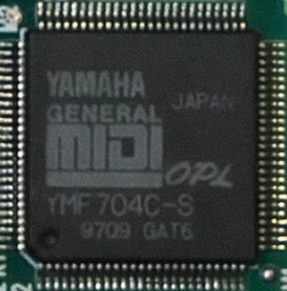 Yamaha YMF-704C
Yamaha YMF-704C
Released: 1996
ROM Size: 1 MB ROM
Patchset: "Fat Labs" OPL4
GM-compatible: Yes
Polyphony: 24 voices
The Yamaha YMF-704C is essentially a YMF-278 that also contains an embedded 1 MB ROM (as opposed to the YMF-278 that required an external ROM chip to store its samples), MPU-401 interface and supports General MIDI. Broadly recognized as very budget-oriented synth chip, with very poor quality samples.
Click here for the YMF-704C datasheet.
Used on the following:
Summary
With the more widespread adoption of the PCI bus around 1994, cheaper / larger capacities of RAM on a typical PC resulted in most sound card and integrated audio manufacturers choosing to adopt a "soft wavetable" approach. This meant loading 2MB to 8MB of samples into the PC's main memory without the need for a dedicated ROM chip on a daughterboard or sticks of RAM on the sound card.
Wavetable Daughterboards
Daughterboard cards plug into an existing sound card that has a compatible wavetable 'header' (connector). The most popular header is Creative Labs' Wave Blaster - a daughterboard that plugs into a Sound Blaster sound card to provide the sound card with sample-based synthesis - though there are other proprietary wavetable headers such as Aztech's "Wave Tide" which is not compatible with the Creative header.
These headers use the MPU-401 UART interface on the sound card to send the sample-based sounds to the application or game (just like plugging an external MIDI module in would do). In some cases these were designed to work only from within a Windows DOS command window, so initially you would need to tell Windows that you want it to redirect MIDI from the Game/MIDI port to the wavetable daughterboard. You would then typically choose 'General MIDI' in the game's setup for this to work.
In other cases where your sound card has onboard wavetable synthesis, such as the MediaTrix Audiotrix Pro software, a DOS utility called SETMPU allows you to redirect audio-in and audio-out either to the onboard wavetable chip or to the device connected to the MPU-401 interface (the game port), such as a Roland SC-55 external MIDI module.
Many wavetable daughterboards were launched from a variety of manufacturers, including Creative Labs, Yamaha, Diamond Multimedia, Turtle Beach, NEC and more. The vast majority are 100% compatible with the Creative Wave Blaster header. Below I list out the most common of these DBs:
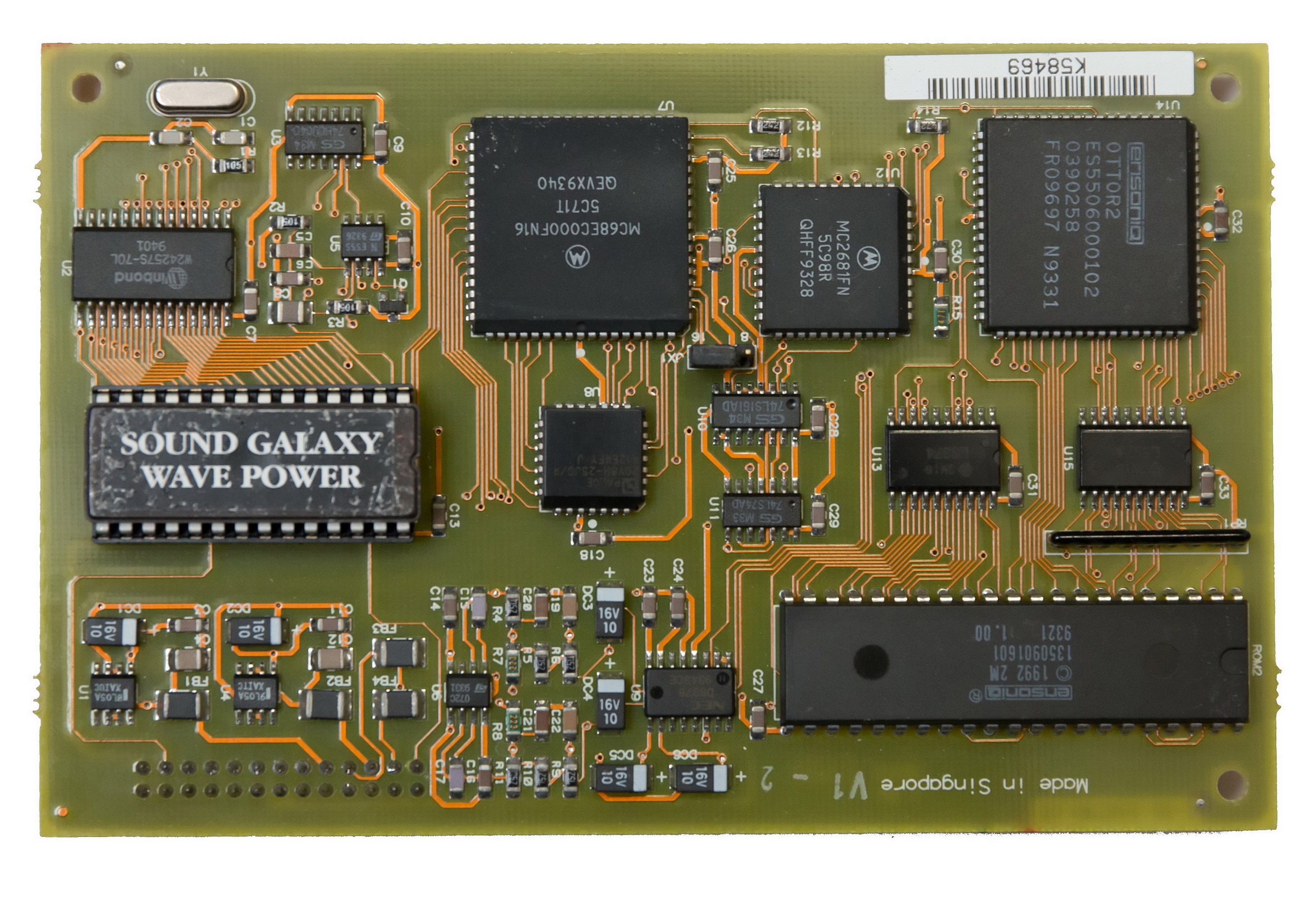 Aztech Sound Galaxy WavePower
Aztech Sound Galaxy WavePower
Price when New: $199, later $129
Also known as the Aztech Power Wave Upgrade, the WavePower uses the Ensoniq OTTOR2 chipset (like the Ensoniq SoundScape DB and Ensoniq VIVO).
It came with either a 2 MB or 4 MB ROM and supports 32-voice polyphony.
From Rich Heimlich back in 1995: "It's a decent Creative Wave Blaster clone but doesn't sound as good as one. Used to be the only other choice. Thankfully that's long ago now.". He rated the music quality at a poor 3.5 out of 10.
We found the Wave Power to be a fine substitute product for the Wave Blaster, however, we noted that it did not possess the same richness of sound that its cousin, the prototype Soundscape from Ensoniq, had.
The documentation for this product along with the full implementation of Midisoft's sequencer and its low price make this a good choice for one whose wave table synthesis needs require a daughter card."
Computer Gaming World, October 1993
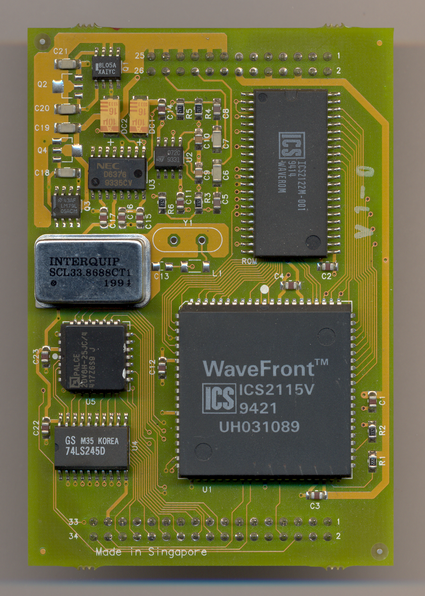 Aztech Wavetide
Aztech Wavetide
The Wavetide uses the ICS WaveFront ICS2115V chipset.
It contains a 2MB ROM and supports 32-voice polyphony. It will only connect to an Aztech board's 50-pin expansion connector (in addition to the proprietary "Wave Tide" header) - it won't work on a standard Wave Blaster header.
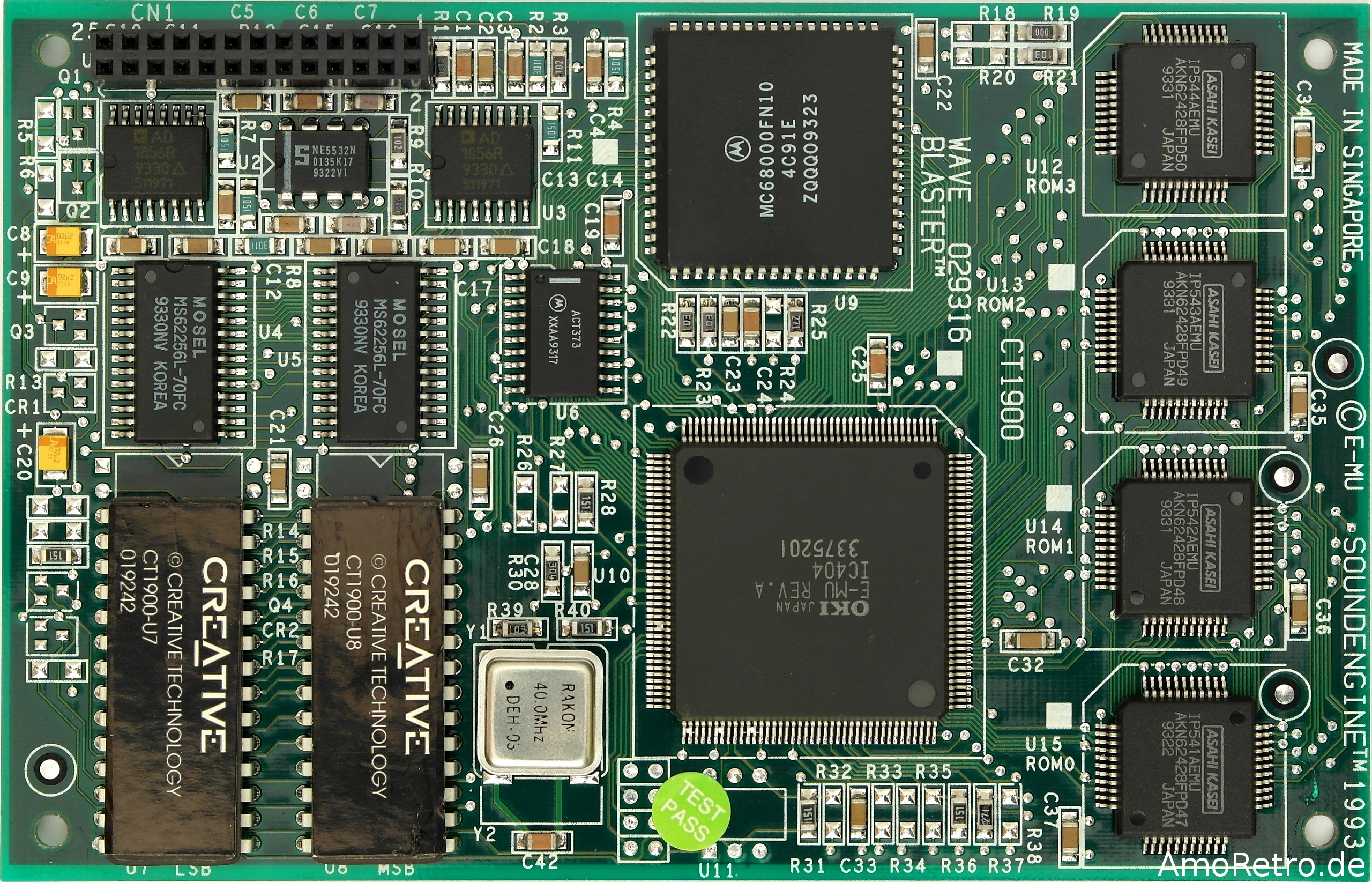 Creative Wave Blaster (CT1900)
Creative Wave Blaster (CT1900)
Price when New: $249.95, later $159
The CT1900 used an OKI-branded E-MU Revision A chip. It has a 4MB ROM and supports 32-voice polyphony.
Computer Gaming World, October 1993
From Rich Heimlich: "We owe this product for getting us the Wave Blaster connector. But even given that, this is just an average choice for add-on products. Not bad, but you can do better both in price and sound quality.".
Original Wave Blaster Rev.3 floppy disk
 Creative Wave Blaster II (CT1910)
Creative Wave Blaster II (CT1910)
Price when New: $160
The CT1910 made use of the new EMU8000 chipset, contained a 2MB ROM, and provides 32-voice polyphony.
Rich Heimlich said this of the WaveBlaster II: "A much better daughterboard than the original Wave Blaster including
a better patch set and effects processor. You're likely to be very satisfied with one. On the downside, the sounds are a bit harsh, the effects are turned up more than usual to hide some flaws and the more esoteric instruments aren't very good.". He scored its music quality at a respectable 7 out of 10.

 Diamond Monster Sound Wavetable (AdWave32)
Diamond Monster Sound Wavetable (AdWave32)
The 512 KB ROM version of this wavetable daughterboard was often found plugged into the Diamond Monster Sound M80 PCI sound card, while the 2 MB ROM version could be found on the Diamond Monster Sound MX300.
Comes in both 512 KB, 2MB (Rev.B) and 4MB ROM (Rev.C) flavours, with the 2MB version supporting 32-voice polyphony and the 4MB version supporting 64-voice polyphony.
The 512 KB (left pic) and 2MB (right pic) versions use an AdMos QDSP QS1000 synth chip.
The 4MB version uses a Dream SAM9733 synth chip.
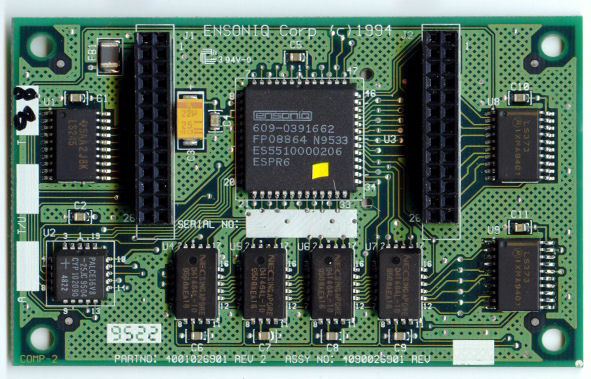 Ensoniq Soundscape DB
Ensoniq Soundscape DB
Price when New: $90
A 'wavetable' daughterboard (sample-based synthesis daughterboard) upgrade for PCs with a sound card bearing a Wave Blaster-compatible connector. It was based upon the SoundScape S-2000 chipset but without the digital sound effects section or any DAC. The SSDB would use the host sound card for final output. There are 2 flavours of this daughterboard: Revision A has a 2MB ROM chip. Revision B has a 1MB ROM chip.
From Rich Heimlich: "People will ask why they would want a 1MB patch set instead of a 2MB set. Size isn't everything. The 1MB set on this DB is the best 1MB set you're going to find. It ends up rating about the same as the 2MB set but features more Sound Canvas-like patch volumes unlike their original Soundscape 2MB set.". He rated the music quality at 7.0 out of 10.
For the 2MB version, Ensoniq originally shipped this daughterboard with the same 2MB patch set found on their original Soundscape because the 1MB set it claimed to use wasn't done. Early releases had hanging note problems but these were returnable for a newer, corrected unit.
 MediaVision Pro Wave
MediaVision Pro Wave
Released: 1994
Synth chip:
KORG AI2 (Korg MBCS35104)
Sample size: 4 MB
This daughterboard was initially sold separately for owners of sound cards that supported the Wave Blaster header. It was later bundled with MediaVision's own Pro 3D sound card - a Sound Blaster-compatible card - to give a well-rounded overall music solution for PC gamers.
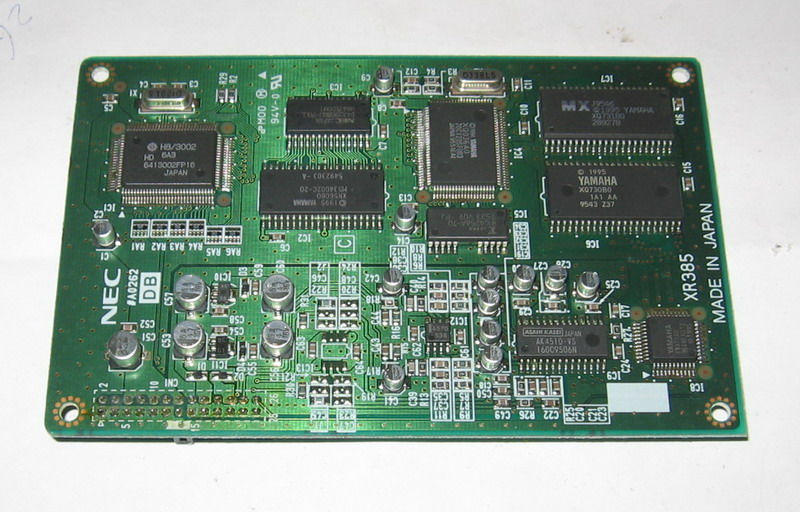 NEC XR385
NEC XR385
A clone of the Yamaha DB50XG. Uses the Yamaha XQ036A0 chipset. Contains a 4MB ROM and supports 32-voice polyphony. It supports the General MIDI standard plus the Yamaha XG extensions.
Arguably the best wavetable card you can buy (the Yamaha may have a little more street cred or cachet over the NEC brand, but they are identical in terms of audio output).
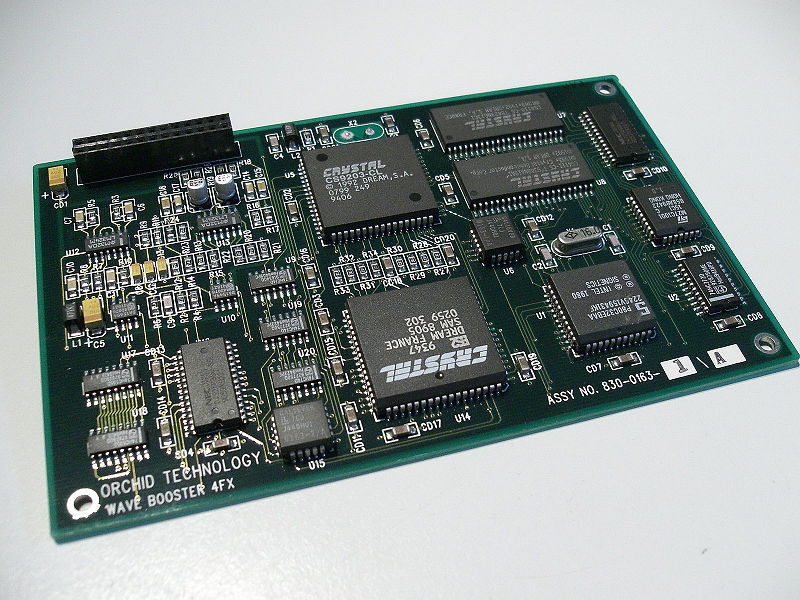 Orchid Wave Booster 2 /4 / 4FX
Orchid Wave Booster 2 /4 / 4FX
Introduced: 1994
Synth chip: Crystal CS9203-CL
Memory: 2 or 4 MB ROM
Polyphony: 32 voices
The WaveBooster came in three flavours:
- WaveBooster/2 (2 MB ROM with 263 sample sounds, 159 melodic timbres and 118 drum sounds)
- WaveBooster/4 (4 MB ROM with 514 sample sounds, 191 melodic timbres and 118 drum sounds)
- WaveBooster/4FX (as WaveBooster/4, but with 46 special effects like reverb, chorus and echo)
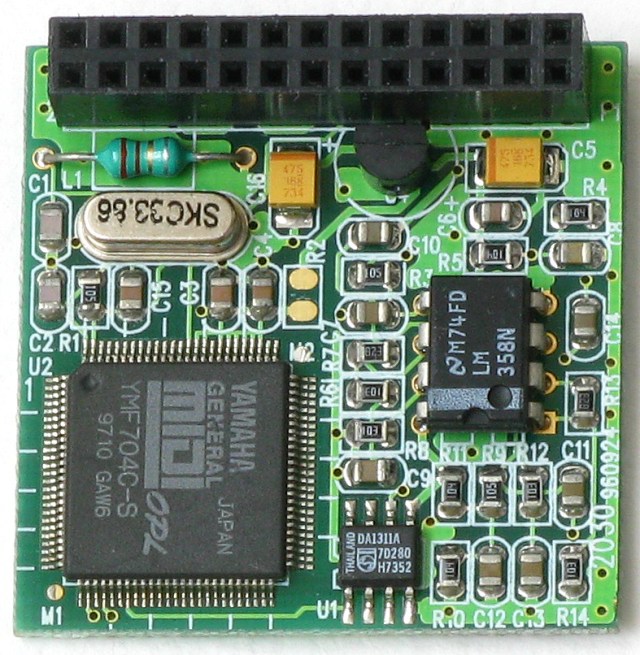 Pine PT-2030 Vivaldi Xtra
Pine PT-2030 Vivaldi Xtra
Released: 1997
Synth chip: Yamaha YMF-704C-S
Memory: 1 MB
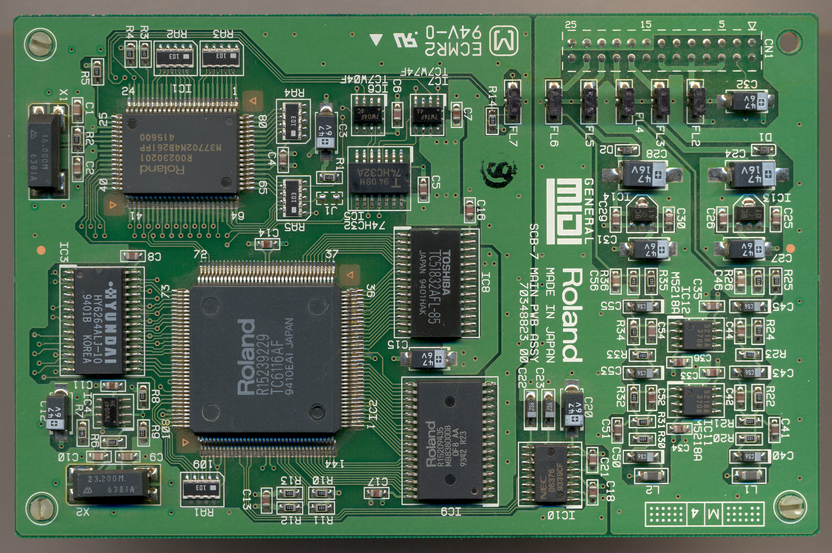 Roland Sound Canvas SCB-7
Roland Sound Canvas SCB-7
Released: 1995
Synth chip: Roland TC6116AF
Memory: 4 MB
Price: $399
The Roland SCB-7 is the daughterboard version of the SC-7 external MIDI synthesizer (which itself is an external version of the SCC-1 but without an MPU-401 interface). This means the output quality is almost up there with the Roland SC-55 Mk II.
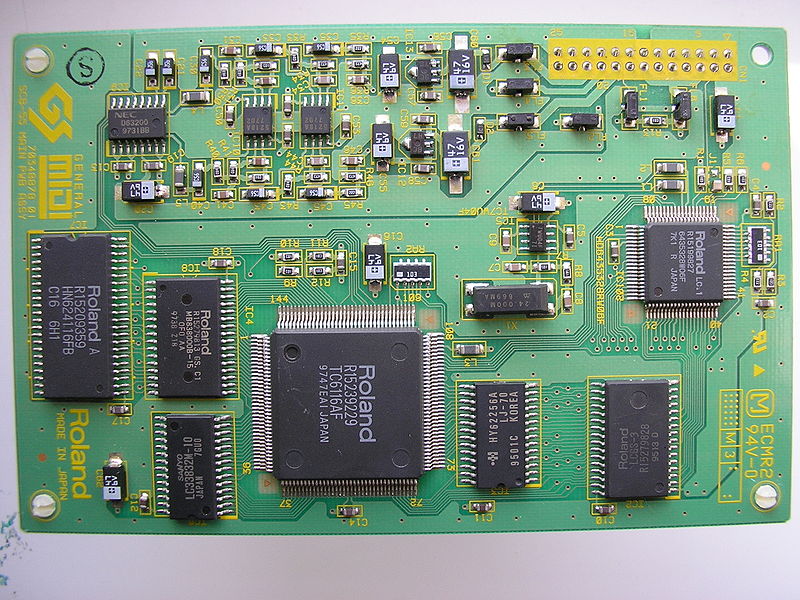 Roland Sound Canvas SCB-55
Roland Sound Canvas SCB-55
Released: 1995
Synth chip: Roland TC6116AF
Memory: 4 MB
Polyphony: 28 voices
This is essentially an SC-55 on a daughterboard, without the bells and whistles. It is fully GM and GS compatible.
 Shark Multimedia Tsunami
Shark Multimedia Tsunami
Released: (Unknown)
Synth chip: Dream SAM9233
Memory: 1 MB or 2 MB
No information is known about this wavetable daughterboard - let me know if you have anything I can put in here!
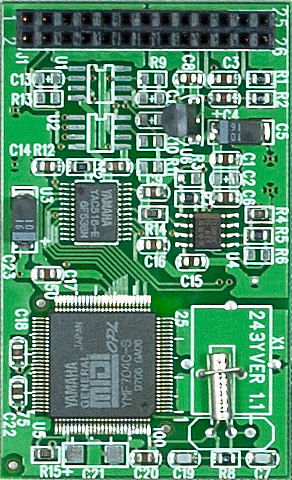 Shuttle HOT-243Y
Shuttle HOT-243Y
Released: 1997
Synth chip: Yamaha YMF-704C-S
Memory: 1 MB
The "SpaceWalker SoundSystem" moniker was used by Shuttle for a number of their mainboards (HOT-613, FV-24, 591P, HOT-661 and more), but it was also used to describe their one and only wavetable daughterboard - the HOT-243Y.
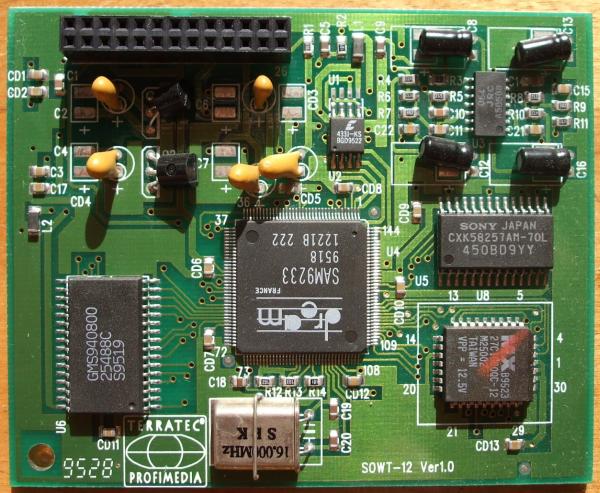 Terratec MiniWaveSystem
Terratec MiniWaveSystem
Released: 1995
Synth chip: Dream SAM9233
Memory: 1 MB
This was perhaps Terratec's first wavetable daughterboard, based on the Dream SAM9203 coupled with the Dream SAM8905 effects processor.
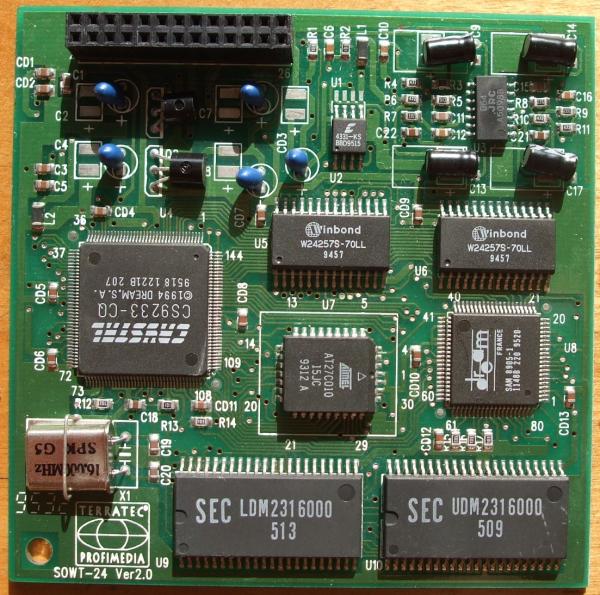 Terratec WaveSystem Professional
Terratec WaveSystem Professional
Released: 1995
Synth chip: Dream SAM9233
Memory: 4 MB
An enhancement over the MiniWaveSystem, this was based on the Dream SAM9203, 4 MB ROM, and got the Dream SAM8905-1 effects processor.
 Terratec Dream GSWave
Terratec Dream GSWave
Released: 1997
Synth chip: Dream SAM9203
Memory: 4 MB
Wavetable daughterboard based on the Dream SAM9203 coupled with the Dream SAM8905 effects processor.
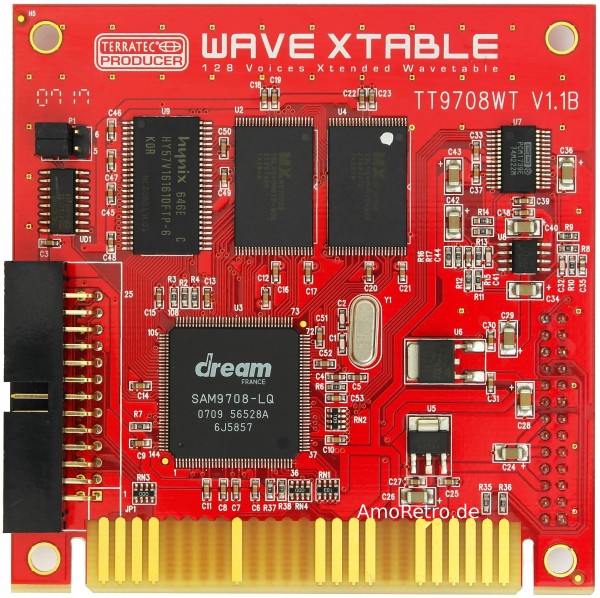 Terratec Producer Wave XTable
Terratec Producer Wave XTable
Released: 2005
Synth chip: Dream SAM9708
Memory: 16 MB
Has a whopping 16MB ROM chip and supports 128-voice polyphony. It is fully General MIDI compliant and also supports the Yamaha XG extensions. It comes with 500 additional instruments, 10 drumkits, and effects.
You would think based on the above that this Terratec is the "killer" wavetable daughterboard to get. It's not - samples aren't in the same league as Roland or Yamaha.
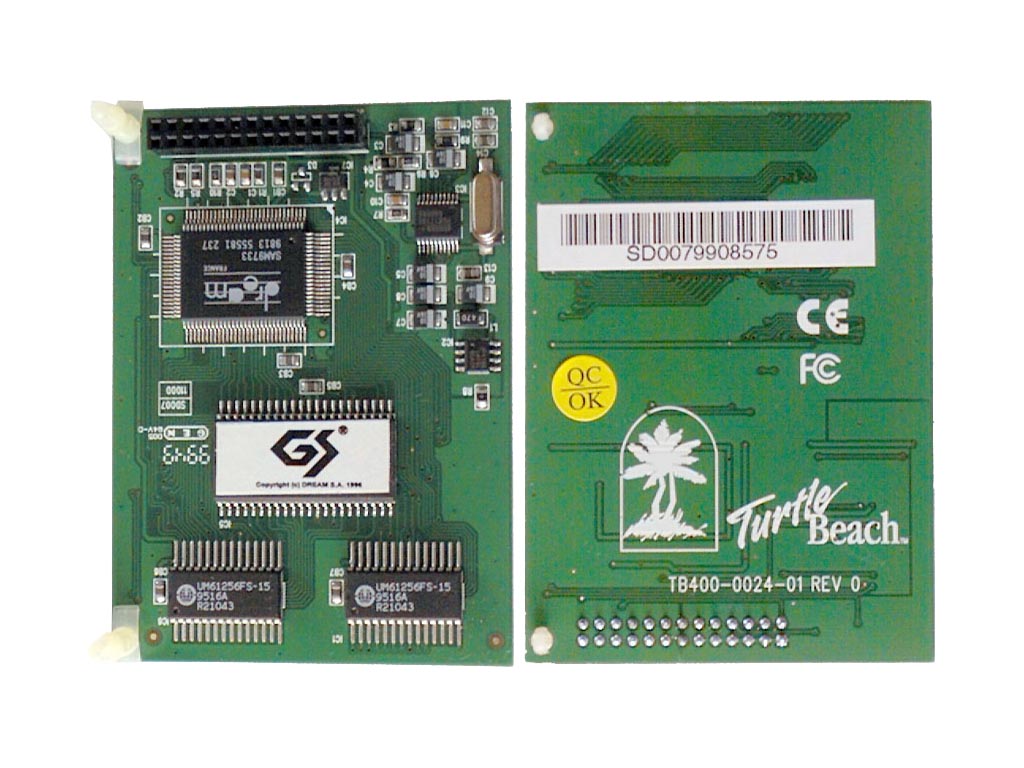 Turtle Beach Cancun FX
Turtle Beach Cancun FX
Introduced: 1998
Synth chip: Dream SAM9733
Memory: 4 MB
Polyphony: 64 voices
The CancunFX was part of the Montego II Home Studio set.
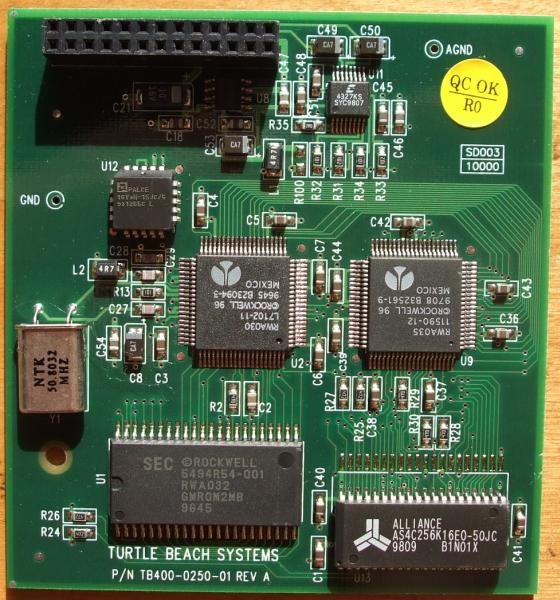
 Turtle Beach Kurzweil HOMAC
Turtle Beach Kurzweil HOMAC
Introduced: 1996
Synth chip: Rockwell/Kurzweil RWA030/035
Memory:
2 MB ROM (4 MB compressed using Kurzweil's proprietary compression)
Polyphony:
32 voices
General MIDI compliant. Considered one of the best sounding daughterboards money can buy.
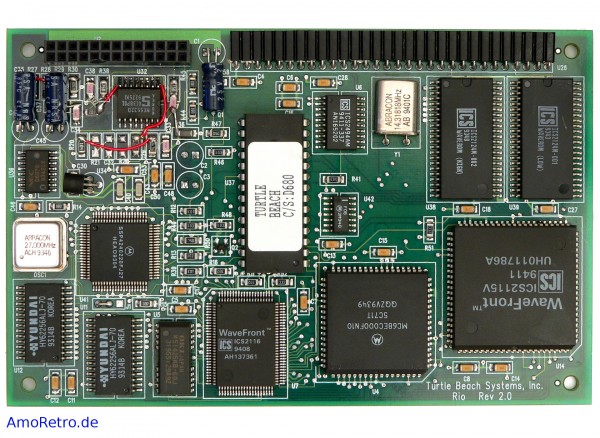 Turtle Beach Rio
Turtle Beach Rio
Price when New: $140
Uses the ICS Wavefront ICS2115V chipset. Has a 4 MB ROM plus a socket for a SIPP RAM module to extend its capacity. 32-voice polyphony. Fully General MIDI compliant.
Much better sound than Creative's Wave Blaster at a better price. RAM sampling and limited effects are a bonus but the RAM sampling is painfully slow due to the WB (Wave Blaster) interface which is why no other DB's offer this feature. The Turtle Beach Rio is used on the Monterey so it can be hard to find.
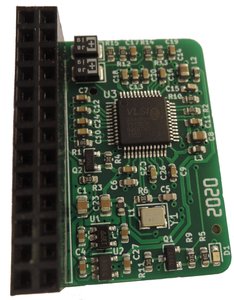 VLSI Solutions VS1053
VLSI Solutions VS1053
Released: 2009
Synth chip:VS1053b
Memory: ?
Polyphony: ?
The VS1053 is believed to have been designed for the portable MP3 market before smartphones became popular, as at its heart is an Ogg Vorbis/MP3/AAC/WMA/FLAC and WAVMIDI audio decoder as well as a PCM/IMA ADPCM/Ogg Vorbis encoder coupled with a MIDI synthesizer.
Found on the following cards:
- Serdaco McFly - a cheap-as-chips Wave Blaster-compatible daughterboard originally sold in 2020 for 30 EUR by Serdashop. See image above.
 X Technology Topwave 32 (XTOP-005)
X Technology Topwave 32 (XTOP-005)
I have no information on this wavetable daughterboard.
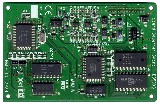 Yamaha DB50XG
Yamaha DB50XG
Uses the Yamaha XQ036A0 chipset.
The XG is for "eXtended General MIDI", similar in purpose to Roland's GS standard - basically a superset of the GM standard. These cards have a 4MB ROM chip for sample storage, and offer 32-voice polyphony. Fully GM and XG compliant.
The DB50XG is basically a Yamaha MU10 external synth module on a daughterboard. It also supports Yamaha TG300, QS300, XG, and Roland GS modes.
Works well with Sound Blaster cards that have a Wave Blaster header, as long as you don't use it together with the Sound Blaster card's digital sound effects due to the hanging note bug that was prevalent on Creative's cards.
As mentioned, about the best-quality daughterboard you can find.
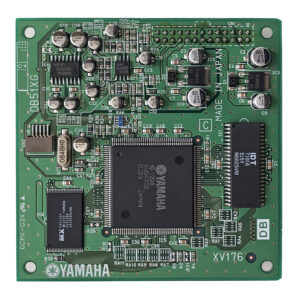 Yamaha DB51XG
Yamaha DB51XG
Introduced: 2000
Uses the Yamaha XU947Co chip.
The XG is for "eXtended General MIDI", similar in purpose to Roland's GS standard. These cards have a 4MB ROM chip for sample storage, and offer 32-voice polyphony. Fully GM, GS and XG compliant.
The DB51XG differs from the DB50XG in that it does not include the QS300 mode sound samples. The DB51XG was the daughterboard that came inside the Korg NX5R external MIDI synth module.
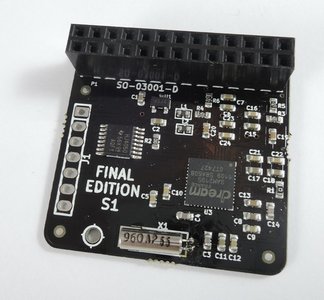 Serdashop Dreamblaster S1
Serdashop Dreamblaster S1
A modern-day (2019) wavetable synthesizer module for use with any Wave Blaster-compatible sound card, e.g. SoundBlaster 16, Audician 32, ESS AudioDrive, Aureal Vortex 2 and many others. Based on the SAM2195 chip.
If you don't have a wavetable connector on your sound card, you can still use the S1 with the addition of the CHiLL and Phil Adapter which allows you to connect the S1 to your sound card's MPU401-compatible Game/MIDI port.
Succeeded by the Dreamblaster S2.
- 64-voice polyphony (without effects)
- 38-voice polyphony + effects
- High quality, compact size
- CleanWave(TM) soundset
- General MIDI compatible effects
- 4-band stereo equalizer
- Low power consumption, only 5V supply required (no +/- 12V)
- Low noise audio output
- Can be used on Waveblaster Compatible soundcards
- Can be used for electronics projects, such as arduino, raspberry pi, midibox,...
- Small size, ideal for building into projects : 36mm x 35mm
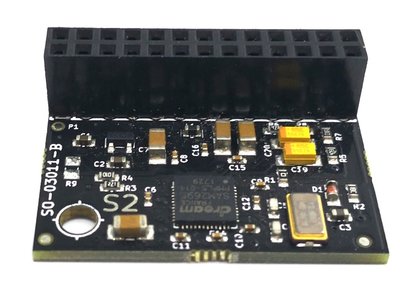 Serdashop Dreamblaster S2
Serdashop Dreamblaster S2
The Dreamblaster S2 is a modern-day Waveblaster-compatible synth module based on the SAM2695 chip. Available to buy new in 2019!
Excellent for gaming, music production, sound experiments,..
Combines wavetable and FM synth sound for a high end retro sound.
If you don't have a wavetable connector on your sound card, you can still use the S2 with the addition of the CHiLL and Phil Adapter which allows you to connect the S2 to your sound card's MPU401-compatible Game/MIDI port.
- 64-voice polyphony (without effects)
- 38-voice polyphony + effects
- High quality, compact size
- CleanWave(TM) soundset
- General MIDI compatible effects
- 4-band stereo equalizer
- Low power consumption, only 5V supply required (no +/- 12V)
- Low noise audio output
- Can be used on Waveblaster compatible soundcards
- Can be used for electronics projects, such as arduino, raspberry pi, midibox,...
- Very small size, ideal for building into projects : 24mm x 34mm
As per Serge's website:
Cheap but brilliant replacement for the more and more becoming less available GM-daughterboards like famous Roland SCB-7 or Yamaha DB50XG.
Compatible with any soundcard that has a Waveblaster connector : SoundBlaster 16, Audician 32, ESS AudioDrive, Aureal Vortex 2 and many others.
Please note: There are some older soundcards with a Waveblaster compatible header but don‘t have an MPU401 interface. Instead there is only the SoundBlaster MIDI standard supported so the games that run with the S2 module are limited. You can use SoftMPU to emulate the MPU401 interface in this case. Visit http://bjt42.github.io/softmpu/ for further information and a list of compatible games.
.jpg)
.jpg)
Images courtesy of DOS Days' contributor, targeted.
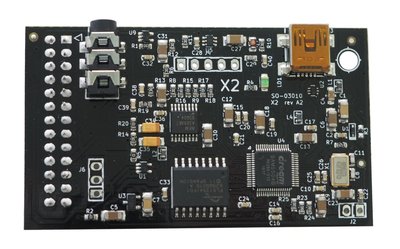 Serdashop Dreamblaster X2
Serdashop Dreamblaster X2
The Dreamblaster X2 takes the modern-day Dreamblaster S2 to another level. Available to buy new in 2019!
- Small form factor midi PCB : 65mm x 38mm size
- Black color PCB
- Dream 5000 series synth chip with 81 voices polyphony, high quality effects engine
- Waveblaster-compatible connector for use on soundcards (such as Soundblaster 16, Audician 32, ESS AudioDrive, Aureal Vortex 2 and many others...) and DIY projects.
- It will also work on instruments that accept Waveblaster cards, such as Oberheim MC2000, Korg NS5R and Terratex Axon AX 100
- Super low latency <1ms
- 64mbyte flash for soundbank data
- USB MIDI in (Class compliant midi device, works on windows XP and higher, without drivers)
- Stereo line out using a high quality 24 bit DAC
- Preloaded with a high quality 16 megabyte Dream General MIDI soundbank
- Advanced MIDI commands spec available.
- DreamBlaster preset editor / USB uploader tool for advanced customization/tweaking.
If you don't have a wavetable connector on your sound card, you can still use the X2 with the addition of the CHiLL and Phil Adapter which allows you to connect the X2 to your sound card's MPU-401-compatible Game/MIDI port.
** UPDATE 2023: Sergey has now released an updated version of the X2 called X2SE (Second Edition) which is the same in functionality but is a slightly smaller size - especially good if you are installing on a card that doesn't provide much space for a daughterboard! **
 Serdashop Dreamblaster X2GS
Serdashop Dreamblaster X2GS
The Dreamblaster X2GS is based on the earlier X2 and as such still has a 64 MB flash, but this is now split into a 16 MB fixed bank pre-loaded with a licenced 16 MB Roland GS bank, and a 'user bank' for the other 48 MB. Serdaco has a signed agreement with Roland (Crystal/Dream are an official licencee) for this bank, so it cannot be overwritten or changed.
** UPDATE 2023: Sergey has now released an updated version of the X2GS called Dreamblaster X2GS SE (Second Edition) which is identical in functionality but is a slightly smaller size - especially good if you are installing on a card that doesn't provide much space for a daughterboard! **
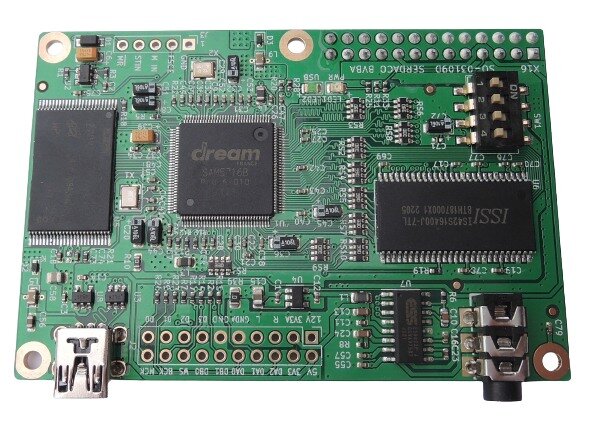 Serdashop Dreamblaster X16
Serdashop Dreamblaster X16
The Dreamblaster X16 is a top-of-the-range GM and GS-compatible wavetable daughterboard built around the high-end Dream SAM5716B synthesizer which supports up to 256 voices and comes with 1 GB of flash memory for sound banks. The full specs are as follows:
- High End 16 core Dream 5000 series synth chip (SAM5716B), with up to 256 voice polyphony
- Compact high quality green, gold plated PCB, 53mm x 77mm
- Super low latency < 1ms
- 8 MByte SDRAM for high quality effects
- 1 GByte Flash for soundbanks
- 2x13 Waveblaster header for integration on DOS sound cards and custom projects
- Up to 400mA current consumption at 5V, when using all DSP cores.
- USB-MIDI interface (Class compliant), USB mini connector
- Stereo out, high quality 24 bit 112 dB DNR DAC
- Expansion header for future expansion / OEM projects
- High quality Dream synth engine, compatible with Dream 5000 SDK for custom soundbank design
- High quality GS compatible reverb and chorus
- 3 Stereo Insert Multi-Effects blocks (Distortion, Equalizer, Compressor, Chorus/Flanger/Phaser/Tremolo/Rotary, Delay), controllable by MIDI.
- 4-bands Equalizer, controllable by MIDI.
- Multi slot soundbank support, fast bank uploading over USB to flash using Serdaco X16Manager multi slot upload tool
- Bootloader for updating firmware over USB
- Support for DreamBlaster Presets
X16 is shipped with the following preloaded soundbanks :
- Bank1 & 2 : Dream CleanWave Bank (official)
- Bank3 : Buran Bank
- Bank4 : OPL3-FM General MIDI bank
- Bank5 : GXSCC Chiptune bank